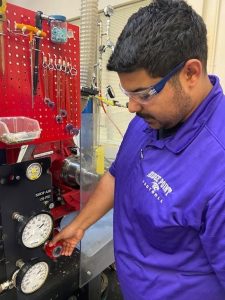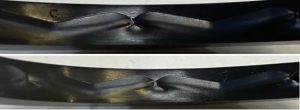In December we reported on successful high-speed rotary seal testing (1,290 RPM) with two Kalsi Seal geometries at dredging and submersible pump conditions. We recently completed even higher speed rotary seal testing with these seals.
As previously described, the high-speed rotary seals used in this testing have a significantly lower hydrodynamic pumping related seal leak rate than other Kalsi Seals used in high-speed applications.
Test setup and results
The high-speed rotary seal test setup is the same as before with one seal having axial spring-loading and the other seal installed in a typical Kalsi seal groove.
The high-speed rotary seals were run on a 2.75” (69.85mm) diameter shaft rotating at 1,800 RPM. An ISO 68 viscosity grade lubricant was pressurized to 50 psi between the seals. The lubricant temperature was maintained at 165°F by intermittently circulating coolant at 4 GPM through the shaft bore. Figure 1 shows one of our Kalsi Seals Lab test technicians setting up the test.
The pair of Enhanced Lubrication SealsTM (PN 568-43-30) was in excellent condition at the conclusion of the 50 hour test, as shown in Figure 2. The per seal leak rate was 18 ml/hour. This high-speed rotary seal test was successfully repeated to confirm performance with a new set of seals.
Testing with a pair of Standard Kalsi Seals (PN 587-12-30) had mixed results. After 25 hours, the 587-12-30 seal without spring loading was in good condition, but the spring-loaded seal had wear on the dynamic interface. This wear is due to the additional load on the seal caused by the spring. The temperature of the seal lubricant between the seals stayed above 220°F even with circulating 4 GPM coolant through the shaft bore. The test was repeated with a pair of new seals and the outcome was very similar.
For the longest seal life, select a seal with the highest hydrodynamic seal leak rate that can be accommodated by the application.
Contact our engineering staff for assistance with dredging and submersible pump seal selection and implementation.


